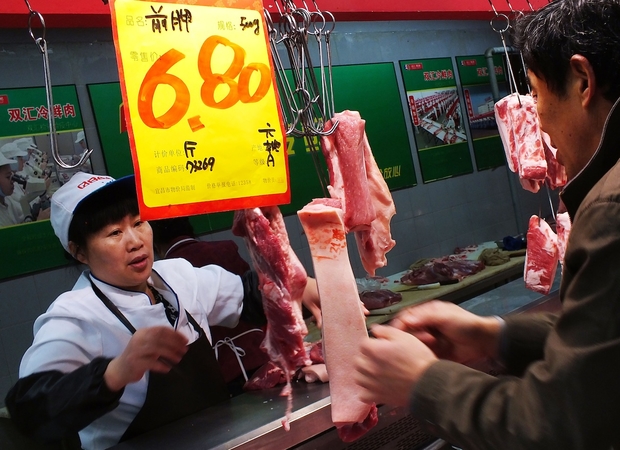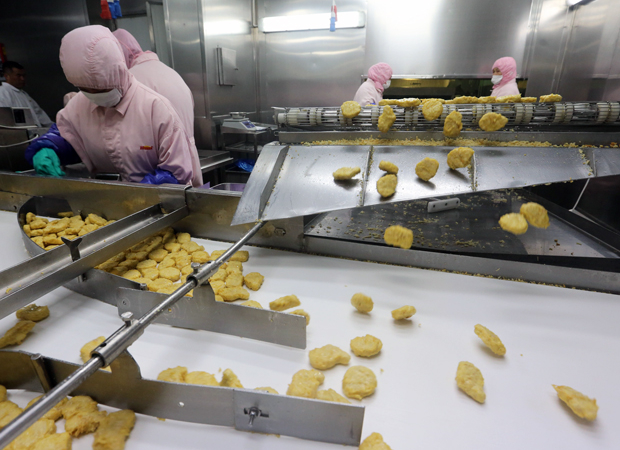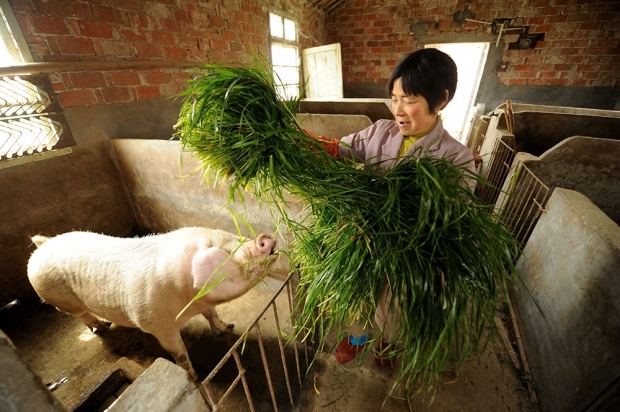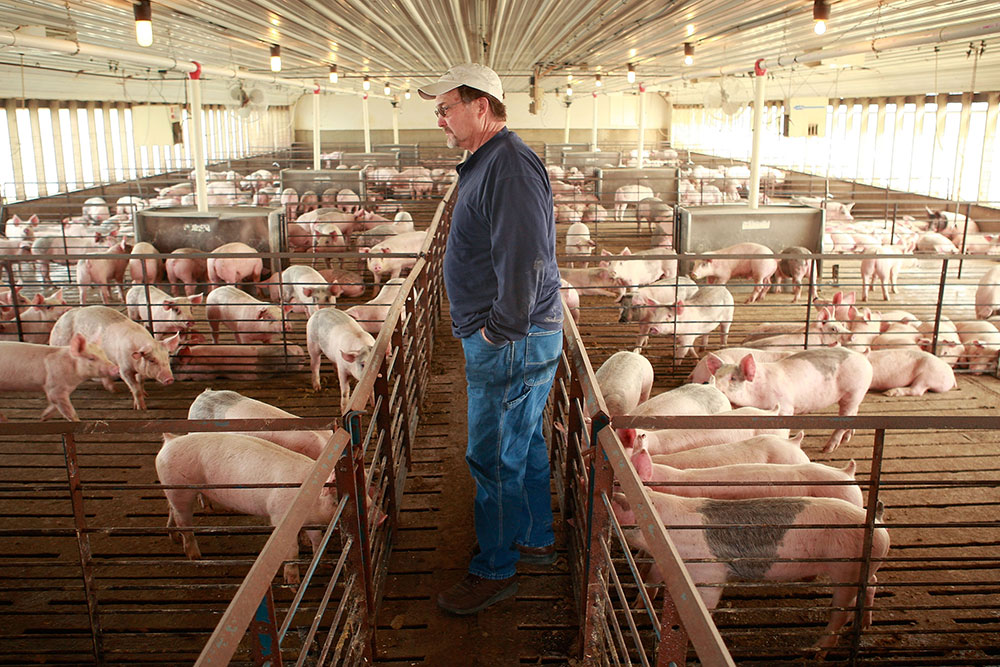Hongshaorou—“red braised” pork belly, a classic Chinese dish—is cooked with ginger, garlic, and soy sauce until the squares of fatty meat are so tender they dissolve in the mouth. Once a luxury, this succulent delicacy was known to be a favorite meal of Chairman Mao Zedong, but today is enjoyed by both ordinary Chinese and wealthy alike, a symbol of China’s shift from an agrarian to an industrialized economy.
As more Chinese are lifted into the urban middle class from rural poverty, meat has become a staple of their diets. China is already the world’s largest pork consumer—the country consumes about 58 million tons of pork per year, according to a 2015 USDA livestock report—and will need to ramp up production to feed what the USDA predicts will be a 15 percent increase in per capita pork consumption from 93 to 107 pounds by 2025. To meet demand, China’s pork producers—mostly small, backyard farmers—are slowly being replaced by large-scale farms similar to those in the United States. According to China’s National Bureau of Statistics, the percentage of backyard pig farmers declined from 73 percent of total pig farmers in 2002 to 34 percent in 2010. Over this same period, the number of mid and large pig farms slaughtering 50 or more hogs per year increased from 27 percent to 66 percent. Some Chinese pork producers are starting to import genetically engineered hogs and new technologies from U.S. companies in an attempt to jump-start production. At this stage, large-scale farms slaughtering more than 3,000 hogs still make up only nine percent of China’s total, but their numbers are expected to grow with the encouragement of the Chinese government. And, while larger-scale farms may help China improve its food chain oversight and safety, a lack of arable land caused by longstanding environmental problems may hamper these efforts before they’ve been ramped up.
Conversation
07.16.13
What’s the Senate’s Beef with China’s Play for American Pork?
“The days in which few pigs were raised in a stall on the family compound and fattened with table scraps are being replaced with a CAFO [Concentrated Animal Feeding Operation]-style production mode which brings a plethora of risks,” says environmental historian Judith Shapiro in an email. “Among these are the increased likelihood of widespread porcine disease (as seen in the 16,000 pigs dumped in the Huangpu River flowing into Shanghai’s drinking water system), the prevalence of antibiotics use and concomitant rise of resistant bacteria, local pollution of waterways from hog farm runoff, the displacement of environmental harm to global forests felled for soybean production (as China cannot produce enough industrial feed on its own), and terrible animal welfare problems because of overcrowding and the sheer increase in numbers of animals brought into the world for pork consumption.”
Both the rising cost of feed as well as fluctuations in pork prices are changes that can put small producers out of business and have precipitated a decline in small pig farmers. According to the USDA, feed costs—which account for 60 percent of a Chinese farmer’s production costs—rose from $.25 per pound in 2006 to $.44 per pound in 2010, a 76 percent increase. In recent years, the shrinking availability of Chinese cropland as well as increased demand from farmers has caused grain prices to increase. Moreover, it’s difficult for small farmers to ramp up production because most lease their land from the government and are constrained by the plots allotted to them. The shift in the competitive landscape of the pork industry has influenced many small farmers to partner with their larger competitors in a bid for survival, and the Chinese government has encouraged the formation of these partnerships with financial incentives.
Viewpoint
07.16.13
CFIUS and the U.S. Senate’s Anti-China Bug
For example, Guangdong Wens Foodstuffs Group—a group of six subsidiary companies that sell fertilizer, animal feed, and livestock—has contracted with small farmers, providing animals, feed, and medicine to them in return for a share of the profits when pigs go to market.
“It’s a way to expand quickly without putting out a lot of capital,” said Michael Boddington, Managing Director of Asian Agribusiness Consulting, a Beijing-based company that advises businesses expanding into Asian agricultural markets. “How do you give real people jobs and make the government happy,” he said.
The gradual push toward industrial farming also supports China’s growing need to improve food safety protocols, a difficult task when farmers are spread out in an informal network throughout the country. “Think about the complexity of monitoring 65 million farmers versus 20 million farmers,” said Boddington.
China may consume more pork than any other nation, but meat is still considered a luxury usually reserved for the middle and upper classes. In Guangzhou’s Tianhe District, restaurants like Yan Yu offer poached pork dumplings, wrinkled dough pockets filled with steaming meat. The cost might be reasonable for a Guangzhou resident who makes a decent living—about U.S.$7—but considered pricy for many of China’s 82 million rural citizens living on less than $1 per day.

Potential buyers survey pigs at a livestock market on the outskirts of Renqiu city, Hebei province.
Guang Niu—Getty Images
Potential buyers survey pigs at a livestock market on the outskirts of Renqiu city, Hebei province.
With their increased buying power, China’s educated middle class consumers are willing to pay more for meat when its origins and food safety standards are better known, putting small backyard farmers at a disadvantage. In a study published in the Journal of Economic and Social Policy, researchers found that 34 percent of those surveyed indicated that they purchased meat labeled “green food,” a Chinese government standard that certifies, among other things, that food can be traced to its origin and limited in what chemicals can be used in production. According to an Institute For Agriculture and Trade Policy report, “China’s Pork Miracle,” consumers “with enough disposable income are increasingly interested in buying food they can trust as being free from illegal additives and other unsafe or imposter materials. For urban consumers in a 2012 study, the most trusted form of pork is from industrial production systems. . .” Though much of China’s food chain is unregulated, larger farms can afford to upgrade their facilities so that meat can be refrigerated and shipped longer distances to its destination, and larger farms can provide greater transparency about where their meat originates.
Environment
08.12.14
China Grows An Interest in Organic Foods
According to a 2011 report called “Feeding China’s Pigs” by the Institute For Agriculture and Trade Policy, small pig farmers, “usually cannot pay for the testing or certification schemes that are currently used to verify hygiene standards (increasingly using the International Organization for Standardization (ISO) system), smallholders are excluded in terms of food safety. At the same time, backyard farmers are largely outside of the subsidy arena, as livestock subsidy programs are by and large aimed at industrializing the sector.” Additionally, pigs raised on small farms are more likely to be kept off-market longer, producing pork that is fattier, but less appealing to customers who prefer healthier cuts of meat. Small farmers must also bear the burden of devastating diseases like porcine epidemic diarrhea (PED)—which can decimate an entire herd—without the benefit of government support or subsidies.
“Government policy mandates that pig farms meet increasingly higher sanitary and safety standards are one factor that is helping push along the consolidation of small-scale pig farms,” said Jenny Tang, an analyst with Smart Agriculture Analytics.
And now, as China shifts to an industrial farm model to feed a growing population of meat eaters, the country looks to the U.S. as a template for how to structure their future business. Some larger Chinese farms have partnered with U.S. companies to teach them the basics of raising large herds of animals. In 2013, the U.S. shipped nearly 14,000 live breeding hogs to China worth $20 million, many of which were genetically bred to produce the maximum number of healthy, high-quality piglets for farmers looking to grow their herds.
Waldo Farms, a Nebraska-based swine genetics firm, has five joint venture partnerships with Chinese companies which they supply with Yorkshire and Duroc breeding sows from their U.S. farm. Chinese farmers use the sows to breed their own herds, which take about three years to grow to 1,000 from the 300 they start with. Waldo also consults with farmers on modernizing their operations to accommodate hundreds or, sometimes, thousands of pigs. “We’re helping them build ultra-modern buildings that have adjoining rooms with ventilation and computer-controlled air movement,” said Max Waldo, CEO of Waldo Farms. “Currently, farmers are ventilating with a few fans and open windows.”
Waldo said his company has shipped about 10,000 live pigs to China since the early ’80s, many of which were used as breeding sows to build herds. Pigs arrive in China via plane, shipped in stacked wooden crates. Flashes of pink skin and snouts are visible between the slats as the crates are hoisted onto pallets to be loaded on-board, where up to 1,100 pigs can be packed into crates on three levels of the plane. Though some farmers may aspire to grow their herds on the scale of large American farms, Waldo said Chinese companies are constrained by both a lack of resources required to grow their operations as well as a dearth of qualified employees.
Whiteshire Hamroc, an Indiana-based swine genetics company, has partnered with Tangrenshen Co. Ltd., a Chinese pork and animal feed company with $326 million in annual revenue, to improve its stock of breeding pigs as the Chinese company transitions to a more industrial form of farming. Whiteshire recently sent nearly 1,200 Yorkshire, Landrace, and Duroc sows to Tangrenshen—hogs chosen for their weight, percentage of lean meat, and tendency to produce large litters—as breeding stock for a herd it is hoped will eventually number 10 million, according to Tangrenshen’s website.
In addition to the pigs that the company provides, Whiteshire sells its proprietary air ventilation system to farmers looking to modernize their hog barns. The vertical ventilation system moves fresh air from the top of the building toward the floor rather than a back-and-forth flow, which, according to Whiteshire’s CEO Mike Lemmon, is optimal for both hogs and workers.
“We determine the building’s ‘pig comfort zone.’ The air quality raises the immune system of the pigs and maintains higher levels of health for them and better air for workers,” said Lemmon.
Additionally, Whiteshire will advise Tangrenshen on optimal genetics to select for certain hog traits such as litter size or body type as well as production methods for more efficient farm operations.
Last year, Chinese-owned WH Group purchased Smithfield Foods—one of the world’s largest pork producers—in a bid to expand pork suppliers beyond the borders of a nation plagued by food scandals and environmental woes. In recent years, China’s mounting environmental problems have included water scarcity and a lack of arable land due to urban encroachment and natural disasters—nearly 30 percent of land has been turned into desert, according to the CFR—making large-scale farming a difficult proposition.
But, China’s headlong push into industrialized meat production may be fraught with environmental perils. Smaller backyard farmers are more likely to feed their pigs food scraps and to use their manure for crop production, whereas in more industrial production, water and land resources must be utilized to grow animal feed. Runoff from industrial farms has polluted lakes and rivers and, in 2013, 16,000 dead, bloated pigs were found floating in the Huangpu River in Shanghai after an unknown farmer illegally dumped them. Its agricultural sector accounts for 50 percent of China’s total emission of methane, a major greenhouse gas.
Despite the challenges of producing pork within its own borders, it’s unlikely that China will relocate the majority of its hog farms overseas. Currently, China produces more than 95 percent of its own pork, says Joe Schuele, a spokesman for the U.S. Meat Export Federation, an industry trade group. Chinese processors favor U.S. imports for their consistency, he said, and it is unlikely that China will lean heavily on other countries for imports. “I can’t even imagine how much they would have to import before it would make a dent in their production,” said Schuele.
He points to U.S. Meat Export Federation statistics from 2014 that showed pork exports to China had decreased from 2011 from about 483,000 metric tons (1.1 million pounds) to about 417,000 metric tons (919,000 pounds) in 2013. “Consumption has cycles,” said Schuele. “Statistically, exports will go down if domestic production goes well.”
And, though it may seem as though the Chinese are ramping up to be global competitors for pork production, experts don’t think it will happen anytime soon. “You need to bring technology transfer when you improve a nation’s hog industry. Their [swine genetics companies] view is if the industry becomes more advanced they’ll use more of their technology,” said Boddington.
Despite the impending threat to its environment, China shows no sign of curbing its appetite for pork. Faced with the challenge of feeding a population now more dependent on a meat-based diet than ever, the government is under increasing pressure to subsidize large-scale pork farms capable of fulfilling that need. At the same time, greater environmental regulations will need to be implemented to prevent air and groundwater contamination. As the world’s greatest pork consumer begins modernizing its vast food production system, China’s agrarian culture may shift drastically. It remains to be seen whether China’s backyard pig farmers can weather the change.





